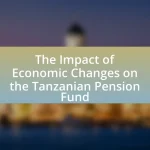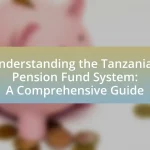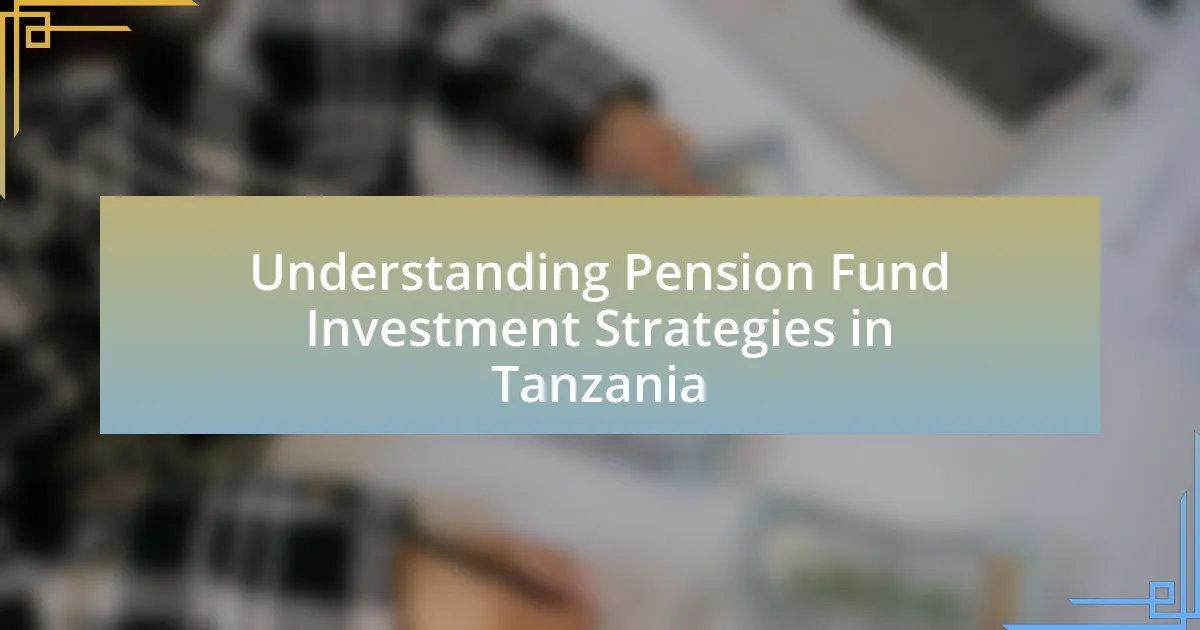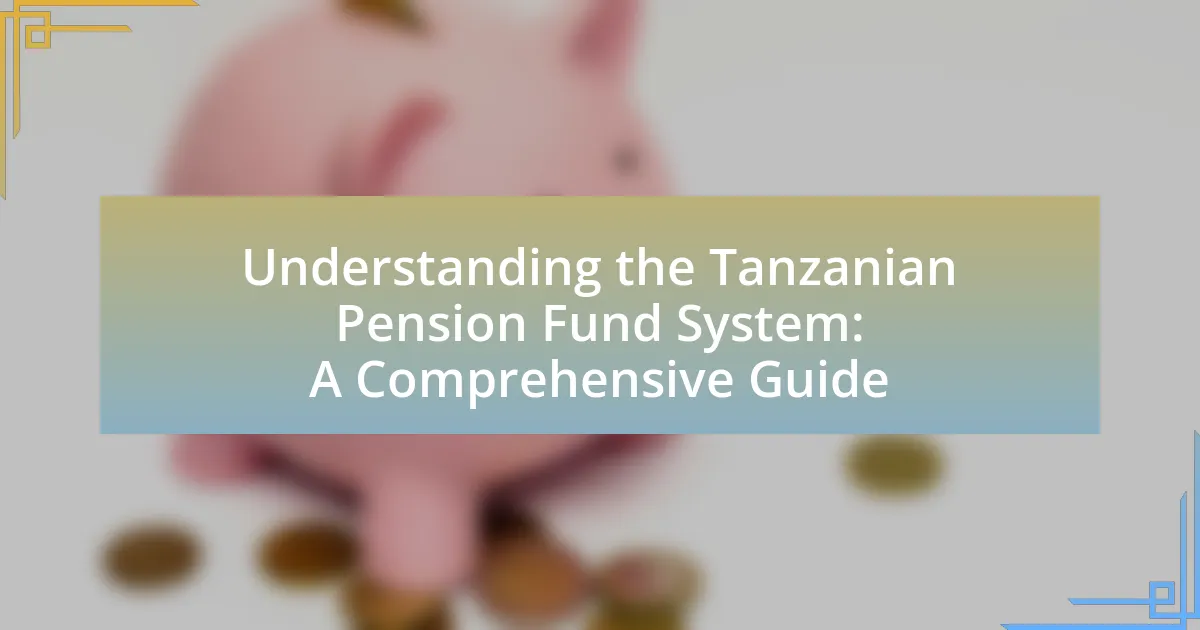The article focuses on the future of pension funds in Tanzania, highlighting current trends and predictions that shape the sector. Key topics include regulatory reforms aimed at enhancing efficiency and sustainability, the impact of demographic changes such as an aging population, and the role of technology in transforming pension fund management. Additionally, it discusses the importance of financial literacy, diversification of investment portfolios, and the influence of economic factors on pension fund growth. The article also addresses challenges facing pension funds, including climate change risks and the need for improved governance practices.

What are the current trends in pension funds in Tanzania?
Current trends in pension funds in Tanzania include increased regulatory reforms, diversification of investment portfolios, and a growing emphasis on financial literacy among members. The Tanzanian government has been implementing reforms to enhance the efficiency and sustainability of pension schemes, as evidenced by the introduction of the National Social Security Fund (NSSF) reforms aimed at improving benefits and coverage. Additionally, pension funds are diversifying their investments into sectors such as real estate and infrastructure to achieve better returns, reflecting a global trend towards alternative investments. Furthermore, there is a significant push for improving financial literacy among pension fund members to ensure better understanding and engagement with their retirement savings, which is crucial for long-term financial security.
How are demographic changes influencing pension funds?
Demographic changes are significantly influencing pension funds by altering the ratio of active workers to retirees, which affects the sustainability of pension systems. As populations age, the number of retirees increases while the workforce shrinks, leading to higher pension payouts and lower contributions. For instance, in Tanzania, the proportion of the population aged 65 and older is projected to rise from 3.2% in 2020 to 5.5% by 2050, which will strain pension resources. This demographic shift necessitates reforms in pension fund structures to ensure long-term viability, such as increasing retirement ages or adjusting contribution rates.
What is the impact of an aging population on pension fund sustainability?
An aging population negatively impacts pension fund sustainability by increasing the ratio of beneficiaries to contributors. As life expectancy rises, more individuals draw pensions for longer periods, while fewer workers contribute to the fund, leading to financial strain. For instance, in Tanzania, the proportion of the population aged 60 and above is projected to rise significantly, which could exacerbate the funding gap in pension systems that rely on current workers’ contributions to support retirees. This demographic shift necessitates reforms to ensure the long-term viability of pension funds, such as increasing retirement age or adjusting contribution rates.
How does urbanization affect pension fund participation?
Urbanization increases pension fund participation by enhancing access to formal employment opportunities and financial literacy. As urban areas expand, more individuals transition from informal to formal employment, which typically includes pension benefits. For instance, in Tanzania, urbanization has led to a rise in sectors such as manufacturing and services, where pension schemes are more prevalent. According to the World Bank, urban employment in Tanzania has grown significantly, contributing to a higher percentage of the workforce being eligible for pension plans. This shift not only increases participation rates but also encourages individuals to engage with financial institutions, thereby improving overall financial literacy and awareness of pension benefits.
What role does technology play in the evolution of pension funds?
Technology plays a crucial role in the evolution of pension funds by enhancing efficiency, transparency, and accessibility. The integration of digital platforms allows for streamlined operations, enabling pension funds to manage investments and member data more effectively. For instance, the use of blockchain technology improves transparency in transactions, reducing fraud and increasing trust among stakeholders. Additionally, data analytics tools facilitate better decision-making by providing insights into market trends and member behavior, which can lead to more tailored pension products. According to a report by Deloitte, 80% of pension funds are investing in technology to improve operational efficiency and member engagement, highlighting the significant impact of technology on the sector.
How are digital platforms transforming pension fund management?
Digital platforms are transforming pension fund management by enhancing efficiency, transparency, and accessibility. These platforms enable real-time data analysis and reporting, allowing fund managers to make informed investment decisions quickly. For instance, the integration of artificial intelligence and machine learning in digital platforms facilitates predictive analytics, which can optimize asset allocation and risk management. Additionally, digital platforms improve communication between fund managers and beneficiaries, fostering greater trust and engagement. According to a report by Deloitte, 70% of pension funds are adopting digital solutions to streamline operations and improve member services, demonstrating a significant shift towards technology-driven management in the sector.
What innovations are emerging in pension fund investment strategies?
Innovations emerging in pension fund investment strategies include the integration of environmental, social, and governance (ESG) criteria, the adoption of technology-driven investment platforms, and the use of alternative assets. ESG investing is gaining traction as pension funds increasingly prioritize sustainable and responsible investment practices, reflecting a broader societal shift towards sustainability. Technology-driven platforms enhance data analytics and decision-making processes, allowing for more efficient portfolio management. Additionally, pension funds are diversifying into alternative assets such as private equity, real estate, and infrastructure to achieve higher returns and reduce risk exposure. These trends are supported by research indicating that ESG investments can lead to better long-term financial performance, as shown in studies by the Global Sustainable Investment Alliance, which reported a 34% increase in global sustainable investment assets from 2016 to 2018.
What regulatory changes are shaping the future of pension funds?
Regulatory changes shaping the future of pension funds in Tanzania include the implementation of the National Pension Fund Act, which mandates increased contributions and improved governance structures. These changes aim to enhance the sustainability and efficiency of pension funds, ensuring better protection for beneficiaries. Additionally, the introduction of the Social Security Regulatory Authority (SSRA) has established stricter compliance requirements and oversight mechanisms, promoting transparency and accountability within the pension sector. These regulatory frameworks are designed to adapt to demographic shifts and economic challenges, ultimately securing the financial future of pension fund members in Tanzania.
How do new policies affect pension fund contributions and benefits?
New policies can significantly alter pension fund contributions and benefits by changing the regulatory framework that governs these funds. For instance, if a government introduces policies that increase mandatory contribution rates, pension funds will receive higher inflows, enhancing their ability to provide benefits in the future. Conversely, policies that reduce tax incentives for contributions may lead to decreased participation, ultimately lowering the funds available for benefits. Historical data from various countries shows that regulatory changes directly impact both the amount contributed by employers and employees, as well as the benefits paid out, illustrating the critical role of policy in shaping pension fund dynamics.
What are the implications of international standards on local pension funds?
International standards significantly influence local pension funds by promoting best practices in governance, risk management, and investment strategies. These standards, such as those set by the International Organization of Pension Supervisors (IOPS) and the International Financial Reporting Standards (IFRS), encourage transparency and accountability, which can enhance the trust of stakeholders in the pension system. For instance, adherence to these standards can lead to improved financial performance and sustainability of pension funds, as evidenced by studies showing that funds aligned with international benchmarks often achieve better investment returns and lower operational risks. Additionally, compliance with international standards can facilitate cross-border investments, allowing local pension funds in Tanzania to diversify their portfolios and potentially increase returns for beneficiaries.

What predictions can be made about the future of pension funds in Tanzania?
Predictions about the future of pension funds in Tanzania indicate a trend towards increased regulatory reforms and enhanced investment strategies. The Tanzanian government is likely to implement policies aimed at improving the sustainability and efficiency of pension funds, as evidenced by the ongoing reforms in the National Social Security Fund (NSSF) and the establishment of the Social Security Regulatory Authority (SSRA) to oversee the sector. Additionally, the growing middle class and urbanization are expected to drive higher contributions to pension schemes, leading to a more robust pension fund landscape. Furthermore, the integration of technology in fund management and member services is anticipated to enhance transparency and accessibility, aligning with global best practices.
How will economic factors influence pension fund growth?
Economic factors significantly influence pension fund growth by affecting investment returns, contributions, and overall fund sustainability. For instance, economic growth typically leads to higher employment rates, which increases contributions to pension funds. Additionally, interest rates impact the returns on fixed-income investments; lower rates can reduce income generated by bonds, while higher rates can enhance returns. Inflation also plays a crucial role; if it outpaces investment returns, the real value of pension assets diminishes. Historical data shows that during periods of economic expansion, such as the 2000s in Tanzania, pension funds experienced substantial growth due to increased contributions and favorable investment conditions. Conversely, economic downturns, like the global financial crisis of 2008, led to reduced contributions and lower asset values, highlighting the direct correlation between economic conditions and pension fund performance.
What is the expected impact of inflation on pension fund returns?
Inflation is expected to negatively impact pension fund returns by eroding the purchasing power of the funds’ assets. As inflation rises, the real value of fixed-income investments, which are commonly held in pension portfolios, declines, leading to lower effective returns for retirees. For instance, if a pension fund yields a nominal return of 5% but inflation is at 3%, the real return is only 2%. Historical data shows that during periods of high inflation, such as the 1970s, many pension funds struggled to meet their obligations due to insufficient returns that did not keep pace with rising prices. This trend indicates that pension funds must adapt their investment strategies to mitigate the adverse effects of inflation on their long-term sustainability.
How might changes in the labor market affect pension fund contributions?
Changes in the labor market can significantly impact pension fund contributions by altering employment levels, wage growth, and the structure of the workforce. For instance, an increase in unemployment rates typically leads to reduced contributions, as fewer individuals are employed and able to contribute to pension funds. Conversely, when the labor market is strong, with rising wages and job creation, contributions tend to increase due to higher disposable incomes and more individuals participating in formal employment. Additionally, shifts towards gig and informal work can complicate pension contributions, as these workers may not have access to traditional pension plans, thereby reducing overall fund inflows. Historical data from various economies shows that labor market dynamics directly correlate with pension fund performance, emphasizing the importance of monitoring employment trends to predict future contributions.
What demographic shifts are anticipated in the coming years?
Anticipated demographic shifts in Tanzania include an increasing aging population and urbanization. By 2050, the proportion of individuals aged 60 and above is expected to rise significantly, from 5% in 2020 to approximately 10%, according to the United Nations. This shift will create greater demand for pension funds and retirement services. Additionally, urbanization is projected to accelerate, with over 50% of the population expected to live in urban areas by 2030, leading to changes in employment patterns and social security needs. These demographic trends will directly impact the structure and sustainability of pension funds in Tanzania.
How will migration patterns influence pension fund demographics?
Migration patterns will significantly influence pension fund demographics by altering the age, income levels, and geographic distribution of contributors. As younger populations migrate to urban areas for better job opportunities, pension funds may see a shift towards a younger demographic, which can affect the overall funding and sustainability of these funds. For instance, in Tanzania, urban migration has led to increased participation in formal employment, thereby expanding the base of contributors to pension funds. According to the World Bank, urbanization in Tanzania is projected to increase, which will likely enhance the number of individuals contributing to pension schemes, thus impacting the demographic profile of these funds.
What trends in life expectancy could affect pension fund liabilities?
Increasing life expectancy trends significantly affect pension fund liabilities by extending the duration over which pension benefits must be paid. As life expectancy rises, individuals are likely to live longer in retirement, leading to higher total payouts from pension funds. For instance, data from the World Bank indicates that life expectancy in Tanzania has increased from approximately 50 years in 2000 to around 65 years in 2020. This increase means that pension funds must plan for longer payout periods, which can strain their financial resources and require adjustments in funding strategies to ensure sustainability.
What are the potential challenges facing pension funds in the future?
Pension funds in Tanzania face several potential challenges in the future, including demographic shifts, economic volatility, and regulatory changes. Demographic shifts, particularly an aging population, can lead to increased payouts and strain fund sustainability. Economic volatility, influenced by factors such as inflation and market fluctuations, can affect investment returns, thereby impacting the funds’ ability to meet obligations. Additionally, regulatory changes may impose new compliance requirements or alter the investment landscape, further complicating fund management. These challenges necessitate proactive strategies to ensure the long-term viability of pension funds in Tanzania.
How might economic downturns impact pension fund stability?
Economic downturns can significantly destabilize pension funds by reducing investment returns and increasing liabilities. During economic recessions, stock markets typically decline, leading to lower asset values for pension funds that rely on equity investments. For instance, the 2008 financial crisis resulted in a 25% average decline in pension fund asset values, which severely impacted their ability to meet future obligations. Additionally, economic downturns often lead to higher unemployment rates, increasing the number of pension fund beneficiaries while simultaneously reducing contributions from active employees. This dual pressure can create funding shortfalls, jeopardizing the long-term sustainability of pension funds.
What risks do pension funds face from climate change and sustainability issues?
Pension funds face significant risks from climate change and sustainability issues, primarily due to potential financial losses from investments in industries vulnerable to environmental regulations and physical climate impacts. For instance, the transition to a low-carbon economy may devalue fossil fuel assets, leading to substantial write-downs. Additionally, extreme weather events can disrupt operations and supply chains of companies in which pension funds invest, resulting in decreased profitability and increased volatility. According to the Task Force on Climate-related Financial Disclosures (TCFD), over $1 trillion in assets could be at risk due to climate-related factors by 2030, highlighting the urgency for pension funds to integrate sustainability into their investment strategies.

What strategies can be employed to enhance pension fund performance in Tanzania?
To enhance pension fund performance in Tanzania, diversification of investment portfolios is essential. By allocating assets across various sectors such as infrastructure, real estate, and equities, pension funds can mitigate risks and capitalize on growth opportunities. For instance, the National Social Security Fund (NSSF) in Tanzania has successfully invested in real estate projects, which has contributed to its financial stability and growth. Additionally, adopting advanced risk management practices and leveraging technology for data analytics can improve decision-making processes, leading to better investment outcomes. Studies indicate that pension funds that utilize technology-driven strategies tend to outperform those that do not, highlighting the importance of innovation in enhancing fund performance.
How can pension funds diversify their investment portfolios?
Pension funds can diversify their investment portfolios by allocating assets across various asset classes, including equities, fixed income, real estate, and alternative investments. This strategy reduces risk and enhances potential returns by spreading investments across different sectors and geographic regions. For example, a study by the World Bank indicates that diversification can lower portfolio volatility by up to 30%, thereby improving risk-adjusted returns. Additionally, incorporating alternative investments such as private equity or infrastructure can provide exposure to non-correlated assets, further enhancing diversification.
What alternative investment opportunities should pension funds consider?
Pension funds should consider alternative investment opportunities such as private equity, real estate, infrastructure, and hedge funds. These asset classes can provide diversification and potentially higher returns compared to traditional investments like stocks and bonds. For instance, private equity has historically outperformed public equity markets, with a Cambridge Associates study showing that U.S. private equity funds returned an average of 14.3% annually over the past 20 years. Real estate investments can offer stable cash flows and appreciation, while infrastructure projects often provide inflation protection and long-term stability. Hedge funds can employ various strategies to generate returns regardless of market conditions, making them a valuable addition to a pension fund’s portfolio.
How can pension funds balance risk and return effectively?
Pension funds can balance risk and return effectively by diversifying their investment portfolios across various asset classes, including equities, bonds, real estate, and alternative investments. Diversification reduces the impact of poor performance in any single asset class, thereby stabilizing overall returns. For instance, historical data shows that a well-diversified portfolio can reduce volatility by up to 30% compared to a concentrated investment strategy. Additionally, pension funds can employ risk management techniques such as asset-liability matching and dynamic asset allocation to adjust their investment strategies based on changing market conditions and demographic factors. This approach allows pension funds to optimize returns while managing risks associated with market fluctuations and longevity.
What best practices can improve pension fund governance?
Best practices that can improve pension fund governance include establishing a clear governance framework, ensuring transparency in decision-making, and implementing robust risk management processes. A clear governance framework defines roles and responsibilities, which enhances accountability among board members and stakeholders. Transparency in decision-making fosters trust and allows stakeholders to understand how funds are managed, as evidenced by the International Organization of Pension Supervisors, which emphasizes that transparency leads to better stakeholder engagement. Robust risk management processes help identify, assess, and mitigate potential risks, ensuring the long-term sustainability of pension funds. According to the World Bank, effective risk management is crucial for maintaining the financial health of pension systems, particularly in emerging markets like Tanzania.
How can transparency and accountability be enhanced in pension fund management?
Transparency and accountability in pension fund management can be enhanced through the implementation of robust regulatory frameworks and the adoption of technology for real-time reporting. Regulatory frameworks, such as the International Financial Reporting Standards (IFRS), ensure that pension funds adhere to consistent accounting practices, thereby increasing transparency. Additionally, the use of blockchain technology can facilitate real-time tracking of fund transactions, making it easier for stakeholders to access information and verify fund activities. A study by the World Bank indicates that countries with stringent regulatory oversight and advanced reporting technologies experience lower incidences of mismanagement and fraud in pension funds.
What role does stakeholder engagement play in pension fund success?
Stakeholder engagement is crucial for pension fund success as it fosters transparency, trust, and collaboration among all parties involved. Engaging stakeholders, including members, employers, and regulators, ensures that their needs and concerns are addressed, leading to better decision-making and enhanced fund performance. Research indicates that pension funds with active stakeholder engagement strategies tend to achieve higher member satisfaction and retention rates, which are essential for long-term sustainability. For instance, a study by the International Labour Organization highlights that effective communication and involvement of stakeholders can significantly improve the governance and accountability of pension funds, ultimately contributing to their success.
What practical steps can individuals take to prepare for retirement?
Individuals can prepare for retirement by establishing a comprehensive savings plan that includes contributing to pension funds, individual retirement accounts (IRAs), and other investment vehicles. Research indicates that starting to save early significantly increases the total retirement savings due to compound interest; for instance, saving just $200 a month from age 25 can yield over $1 million by retirement age, assuming a 7% annual return. Additionally, individuals should regularly review and adjust their investment portfolios to align with their retirement goals and risk tolerance, ensuring they are on track to meet their financial needs in retirement.





